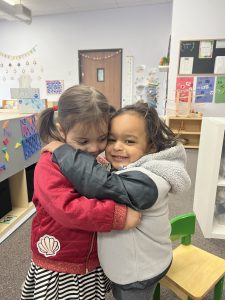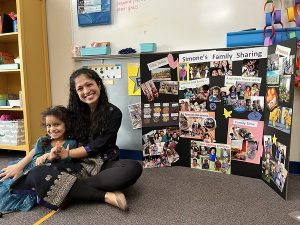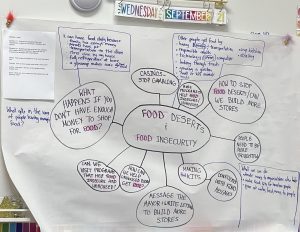The Seed social justice curriculum is embedded in the regular emergent curriculum. It is customized for each class each year based on the interests and composition of the class. Social justice topics are interwoven throughout the year rather than studied at one specific time. Practices that support social justice contribute to social/emotional development and are present at every age level, beginning with our toddlers. Although the curriculum looks different for each age group (see below), there are overarching threads that weave through its entirety. Here is a presentation that summarizes it:
An Education for Life as Global Citizens
Toddlers
 In our toddler program, social justice is all about acquiring language and learning how to use it. For our youngest students, teachers first provide and model the language they want the children to eventually use. For example, if a child takes another child’s toy, the teacher will bring the two children together and say something like, “Tell her ‘I don’t like it when you take my toy.’ (to other child) “Do you want a turn?” (if child indicates yes) “Say ‘I want a turn.” Even though the teacher is doing all or most of the talking at this phase, eventually the children begin to use language to express needs.
In our toddler program, social justice is all about acquiring language and learning how to use it. For our youngest students, teachers first provide and model the language they want the children to eventually use. For example, if a child takes another child’s toy, the teacher will bring the two children together and say something like, “Tell her ‘I don’t like it when you take my toy.’ (to other child) “Do you want a turn?” (if child indicates yes) “Say ‘I want a turn.” Even though the teacher is doing all or most of the talking at this phase, eventually the children begin to use language to express needs.
As toddlers acquire language, they become quite proficient with statements such as
“My turn,” or “One minute…” (how much time they still need with a toy or before a new task). They eventually learn to use their voices to advocate for themselves and each other. Children continue practicing expressing what they need/want with the support of their teachers. They are also introduced to social justice vocabulary through books such as the You Are Friendly series.
When toddler teachers select a social justice standard, they often choose the domain of identity. An example of how toddlers approach identity looks like this: SJ standard T2
Preschool
Preschool students delve into social justice topics in a variety of ways. They continue work with identity, and are able to move into the domain of diversity within the standards. Teachers draw on a variety of books (see resources for a few of the titles used) as starting points for discussions. For example, a book like Bodies Are Cool by Tyler Feder inspires conversation about similarities and differences in an incredibly inclusive way. Conversations begin with essential questions like these from our Preschool 4s class:
• How do I talk about myself? How do I learn more about myself and share it with the class?
• How do the parts of me shape how I interact with my classroom community? How do I share parts of myself with my classroom community?
• How did I get this way? What are my specific family dynamics that help shape who I am?
• What can I do about it? What part of my lived experience can I share with the world in order to build acceptance, understanding, and appreciation of me and all people?
 All of our preschool classes organize activities that build community with families. These range from garden cleanup, outdoor building projects, special sharing by parents and their child, and larger events, such as Día de los Muertos celebrations that bring parents to the classroom for a presentation about their ancestors and share a lunch the children help to prepare. Families are encouraged to share their cultural backgrounds on an ongoing basis. The preschool social justice curriculum has a strong emphasis on building social skills, particularly enhancing how to language is used. In the PreK class children utilize the peace table, where children learn to go for solving problems with each other. With support and modeling throughout a school year, students are able to engage in this process independently, setting them up to be an advocate for themselves and others.
All of our preschool classes organize activities that build community with families. These range from garden cleanup, outdoor building projects, special sharing by parents and their child, and larger events, such as Día de los Muertos celebrations that bring parents to the classroom for a presentation about their ancestors and share a lunch the children help to prepare. Families are encouraged to share their cultural backgrounds on an ongoing basis. The preschool social justice curriculum has a strong emphasis on building social skills, particularly enhancing how to language is used. In the PreK class children utilize the peace table, where children learn to go for solving problems with each other. With support and modeling throughout a school year, students are able to engage in this process independently, setting them up to be an advocate for themselves and others.
Elementary
Once students reach the elementary grades, the work in social justice expands considerably. Building on skills developed in younger classes, the focus moves beyond identity studies and more into the remaining domains of diversity, justice, and action. Often the emphasis in each elementary class is driven by needs and interests of the specific group. For example, in one class there was a specific need to raise awareness about gender identity. With consistent communications between parent and teacher, an approach was developed for how to address use of pronouns, give children vocabulary for talking about gender identity, and how to be an advocate for peer feelings around gender identity. Elementary teachers utilize a wide range of picture books, chapter books, and other age appropriate media.
 During a school wide food study in September, 3rd/4th graders were introduced to the term “food desert.” The initial discussion led to further conversation about food insecurity, as local maps were reference points for determining where food deserts are near our school. Guided by essential questions, the class eventually ended up devising a plan to make food kits (bags) to distribute to unhoused persons in the area. Over 200 kits were assembled using donated food items, then passed out to parents to help with distribution. It was an extraordinary project through which young kids were able directly experience the action domain of the social justice standards.
During a school wide food study in September, 3rd/4th graders were introduced to the term “food desert.” The initial discussion led to further conversation about food insecurity, as local maps were reference points for determining where food deserts are near our school. Guided by essential questions, the class eventually ended up devising a plan to make food kits (bags) to distribute to unhoused persons in the area. Over 200 kits were assembled using donated food items, then passed out to parents to help with distribution. It was an extraordinary project through which young kids were able directly experience the action domain of the social justice standards.
